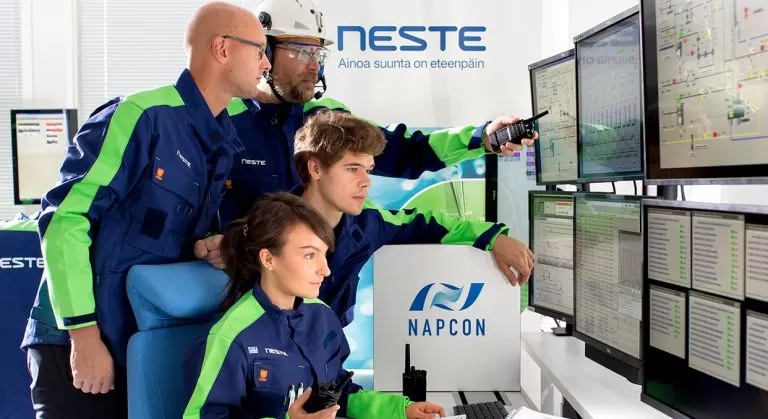The 5 Biggest Virtual And Augmented Reality Trends In 2020 Everyone Should Know About

Share this blog
2019 was a growth year for virtual and augmented reality (VR/AR)– known collectively as extended reality (XR). The presence of these breakthrough technologies began to be felt far away from the fields of gaming and entertainment, where they first became popular.
Virtual reality – where users wear a headset and are fully immersed in computer-generated environments – has been developed to meet design, marketing, education, training, and retail needs. Augmented reality – where computer images are superimposed onto the user’s view of the real world, through a screen or headset – is a more complex challenge, as it requires the software to “see” what is in front of it. But we’re getting used to seeing it used for more than adding cartoon features to selfie pictures or spotting Pokemon in the wild.
With global spending on XR technology is forecast to increase by 78.5% next year compared to this year, both technologies will be key trends to watch out for in 2020. We are likely to see a whole load of exciting new hardware offering even greater immersion and realism, as well as innovative use cases as industry gets to grips with what it can do.
Industrial use outpaces gaming and entertainment
Most people’s first experiences of VR and AR today are likely to be in gaming and entertainment. That’s likely to change, as research shows that the development of enterprise XR solutions is overtaking that on consumer solutions. The 2020 XR Industry Insight report collated by VR Intelligence states that 65% of the AR companies surveyed said they are working on industrial applications, while just 37% working on consumer products and software.
This shouldn’t be surprising – although games made the headlines in recent years thanks to Pokemon Go and Facebook’s Oculus Rift, the potential to boost productivity and safety using XR makes it an attractive proposition for industry. VR can be used to simulate working in dangerous environments or with expensive, easily damaged tools and equipment, without any of the risks. AR, on the other hand, can be used to relay essential information directly to the user about whatever happens to be in front of them – reducing the time spent by engineers, technicians, or maintenance staff referring to manuals and looking up information online while on the job.
Credits: Forbes
Get in Touch
Related Blogs

Balancing Feature Development with Platform Enhancement: A Strategic Imperative

Managing IT Costs Effectively: A Strategic Approach to Balancing Growth and Efficiency

The Hidden Complexity of Scaling Cloud Operations: What Most Strategies Miss

Managing Technical Debt: Balancing Innovation with Sustainability

Maintaining Development Velocity While Ensuring Quality: The Balancing Act

Navigating Financial Strategies for Global Expansion in SaaS

Precision in Complexity: Redefining Capital Allocation for Sustainable Growth

Beyond Silos: Rethinking Cross-Functional Collaboration for Scalable Product Development

Simplifying Global Expansion: The Power of One Strategic Partner

The Unfinished Symphony of Digital Transformation: From Strategy to Execution

Beyond Traditional Process Intelligence: Integrating Emerging Technologies for a Competitive Edge

Tekninen Velka – Kuinka Se Haittaa Kasvua ja Miten Sen Saa Hallintaan?

A Deep Dive into Product Engineering: Process, Roles, and Best Practices

What is Cyber Resilience? An In-Depth Guide

A Comprehensive Guide to Cloud Transformation

24 Emerging Software Development Trends Transforming 2024

Is AI Secure? Addressing Cybersecurity Risks with AI

How Is Cloud Computing Transforming Sustainable Healthcare in the Nordics?

Gateway Digital is Neste Napcon’s Partner in Creating Digital Learning Environments for the Process Industry

Tuotekehitysyhteistyön avulla joustavuutta ja kustannushyötyjä – Case School Day

Petteri paju vahvistamaan Gatewayn myyntiä

Top 6 Trends Transforming Logistics and Supply Chain in 2020

Why is it Important to Hire the Right Employees to Grow your Business?

Miten IT-alan ammattilaisten vaje näkyy Suomessa?

How Can Emerging Technology Facilitate Faster Start-up Growth?

The Need For Smart Logistic Planning: Takeaways From The Suez Canal Crisis

Gateway Digital AS and Retailtech strengthen their strategic partnership

Gateway Digital and Digitate enters strategic partnership

The DACH cloud computing industry in 2021 and beyond

Why Germany is home to the most innovative Tech Startups

Dataplattform för att identifiera bilreservdelar vinner pris inom hållbarhet

AWS vs GCP vs Microsoft Azure: Everything you need to know

Ensuring a higher ROI on your Technology Investment: Here’s How

Why the future of Startups & Scaleups depends on Technology Partner

Infographic: Elevate your Business with Augmented Supply Chain

Infographic: Empowering the Digital Healthcare Ecosystem

Infographic: Why Strategic Technology Partnerships are imperative for ISVs

Infographic: How PES is Empowering the Digital Healthcare landscape

Impact of Covid 19 on the Automotive Industry

How COVID-19 is Changing the Face of Digital Healthcare

Transform your Digital Journey with Strategic Technology Partnerships

Succeed your Business with Partnerships – The New Normal for Fintech!

Supply Chain Focus Areas to Mitigate COVID-19 Disruptions

How Digital Transformation is Redefining the Healthcare Industry

Benefits of Digitising Your Product Development Process

How to Develop a New Product (From Concept to Market)

How Automotive and Technology Experts See the Future of Connected Vehicles through Future Tech 5G Service

Industry Digitization will be Top Opportunity for 5G business solutions

5G Products & Solutions in 2023 & Beyond– What Should we expect from 5g network software?

Everything You Need to Know About 5G network as a service

Cloud Companies Chase Future in Cybersecurity ‘Wild West’

The Future of Lawyers: Legal Tech, AI, Big Data And Online Courts

Why Covid-19 Could Expedite the Role of RegTech in Finance

3 Elements For Success With Mobility As A Service In Our Cities

Digitalization is Upending Global Logistics

Mastering the Duality of Digital: How Companies Withstand Disruption

iGaming Technology Trends to Watch

73% Growth and Instant Blockbusters: How Online Gaming Industry Is Blowing Up During the Pandemic

The 5 Biggest Cybersecurity Trends In 2020 Everyone Should Know About

Why Cybersecurity Is Really A Business Problem

Technological Disruption or Next Industrial Revolution?

What Will Be The Future Success Of Fashion Retail In The Digital Age

The Banking Industry Is Spending Wildly on the Latest Tech

Disruption in Manufacturing: Managing Unexpected Risks

5 Manufacturing Tech Trends Poised To Disrupt Your Business

Digital Disruption in the Manufacturing Industry

Future Factory: How Technology Is Transforming Manufacturing

Five Ways the Internet of Things is Transforming Businesses Today

The Mobility-as-a-Service Market will Register a CAGR of Over 35% by 2023

3 Ways Every Company Should Prepare For The Internet Of Things

The Three Stages Of Cloud Transformation: Application, Network, Security

Cloud Computing Seen as Tech Haven Amid Pandemic Uncertainty

How Multi-Cloud and Digital Transformation Fit Together

8 Ways Cloud Is Transforming Business

Mixed Reality Finds Its Niche in Industrial and Business Applications

Virtual Reality is Making Marketing and Training More Effective for Businesses

What Leaders Need To Know About Augmented Reality

DevOps Model: The Role of Quality Assurance Redefined

Quality Engineering Has DevOps and Agile in the Driving Seat

How QA Can Support Businesses in the Journey of Digital Transformation

Quality Assurance Is Critical In Software Development And Increasingly Automated

Resolving Challenges of Auto ISVs with Fruitful Technology Partnerships

Resolve Fleet Management Challenges with Innovative Digital Automotive Solutions

Top 3 Factors Impacting Customer Satisfaction of Modern Car Buyers

Fleet Telematics Solution: Driving Great Business for Automotive Ecosystems

Top Supply Chain Tech Trends

How Artificial Intelligence Benefits Logistics and Supply Chain Management

Fleet Management in 2024 & Beyond: What Does the Future Look Like?

How to Identify a Trusted online iGaming Solutions Provider?

Mastering Enterprise Digital Transformation: Building Blocks of a Successful Strategy

Center of Excellence: Building Intelligent Solutions for the Enterprises of Tomorrow

Want to Succeed in Digital Transformation? Choose the Right Technology Partner

Customer Satisfaction in an Ever-Evolving iGaming Industry

How to Tackle Security Risks in Digital Transformation

The State of Legal Tech: What Every Legal Business Must Know

Legal Technology in 2020 and Beyond

Want to Succeed in Digital Transformation? Choose the Right Technology Partner

Fulfilling Customer Experiences in the Digital Era: How to Go About It

The Impact of COVID-19 on Digital Transformation

Taking the Pain Out of Application Modernization
INDUSTRIES
PLATFORMS
SERVICES
CONSULTING
- AlvariumTM - Design Led ConsultingOpens a new window
- Digital Marketing Services
- Automotive Aftermarket
- Digital Logistics
- Remote Engineering
